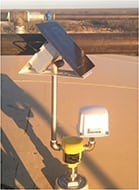Open-architecture wireless system enables sensor choice
Monitoring level in tanks is a common wireless application, and when used in upstream pumping, oil-and-gas, wastewater and other industrial applications, it can help to eliminate run-outs and overflows while optimizing and ensuring the integrity of the operations. The SignalFire Remote Sensing System (photo) integrates an open architecture mesh network, which allows users to choose the preferred sensor type for an application, and to mix different sensor types in the same network. By comparison, most tank level-monitoring systems limit sensor choice, says the company. Depending on the conditions of the operating environment and tank contents, the ideal sensing technology might be a float device, pressure sensor, ultrasonic sensor, piezoresistive sensor, or one based on air-guided wave radar. The SFRSS communicates with and powers virtually any sensor with a 4–20-mA, 1.5-V, Modbus, HART, digital I/O and other analog and digital interfaces, says the company. In a typical application, the SignalFire wireless nodes interface with a standard sensor, providing power for the sensor and connectvity to a gateway located at a central location where the data are concentrated. Because the SFRSS mesh network operates at lower frequencies, it can communicate at ranges of up to 3 miles between nodes, and it is significantly less sensitive to foliage, obstructions and moisture when compared to traditional wireless sensors, according to the manufacturer. — SignalFire, Hudson, Mass.
